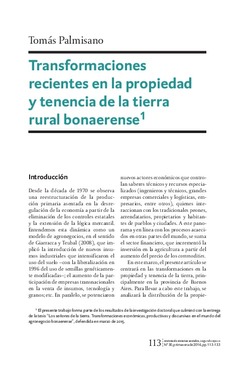Transformaciones recientes en la propiedad y tenencia de la tierra rural bonaerense
Fecha
2016-09Autor
Palmisano, TomásResumen
Durante los últimos años, el mundo rural argentino ha sufrido enormes transformaciones impulsadas por el avance del agronegocio como dinámica productiva hegemónica. En este contexto, el presente trabajo pone de relieve los procesos de concentración y centralización de la tierra en algunos partidos de la provincia de Buenos Aires y, a la vez, explora los vínculos entre las transformaciones productivas en el agro y la ganadería y las tendencias hacia la reducción en el número de explotaciones agropecuarias. Para ello se trabajará, por un lado, sobre el registro catastral de diez partidos de la provincia de Buenos Aires y, por el otro, con datos censales provinciales. Nuestra lectura de dichas fuentes nos permite afirmar que, en un escenario muy heterogéneo, la cantidad de propietarios se ha mantenido estable entre comienzos de la década de 1990 y finales de los 2000, a la vez que hubo una redistribución de la tierra a favor de los propietarios medianos y grandes. Asimismo, el análisis de los datos censales muestra que las trayectorias productivas actuales, más que asentarse plenamente en la toma de tierra, implican la convergencia de la propiedad y el arrendamiento. During the last years the rural Argentinean world has suffered huge transformations as a result of the advance of the agribusiness as an hegemonic productive dynamic. In this context, the present work examines the process of concentration and centralization of land in some districts of the Buenos Aires province (Argentina); and at the same time it explores the links between the productive transformations in the agriculture and cattle with the tendency to reduce the number of agrarian exploitations. For that, we will work with the land ownership register of ten districts of the Buenos Aires province, and also with the provincial census data. After reading these sources allow us to confirm that in a very heterogeneous scenery, the amount of owners have slightly maintained from the beginning of the 1990 decade and the last of 2000, and at the same time it had a land redistribution in favour of the mid and large owners. In the same way, the analysis of census data shows that current productive paths, rather than settle fully into the land lease, involve the convergence of the property and the lease.

